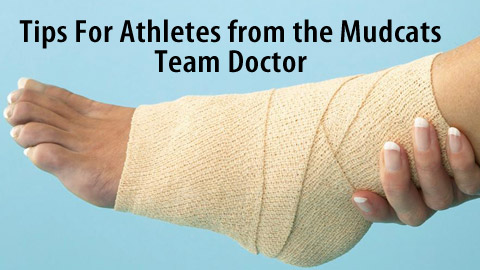Tips For Athletes from the Mudcats Team Doctor
Story by special guest columnist Mark Galland. Dr. Galland is a Board Certified Orthopaedic Surgeon specializing in sports medicine, practicing in Wake Forest and North Raleigh. He serves as team physician and orthopaedic consultant to the Carolina Mudcats.
Cary, NC – As the fall season progresses, it’s important to review some basic information that may help your student athlete stay healthy and perform at the highest level.
Sports Nutrition and Hydration
Athletes should eat a small meal every 3-4 hours. Don’t forget to eat before practice so that you will have enough energy to perform optimally. Any meals you eat prior to practices or games should include 2/3 carbohydrates for the “quick energy” you will need during participation and 1/3 protein for the slower-burn energy that will keep you in the game. Try to avoid milk and fried foods just prior to participation.
One may require up to 2 gallons of water daily when practicing in conditions of high heat and humidity. Young athletes should avoid “energy drinks” as many of these are loaded with sugar and caffeine and can elevate blood pressure to dangerous levels.
R.I.C.E. – An Acronym to Live By
Bumps and bruises are inevitable. Some things you should keep in mind:
Remember R. I. C. E. when dealing with any injury—Rest the injured body part, Ice it, Compress it with tape or a bandage, and Elevate it to control swelling.
Over The Counter Help With Pain
Ibuprofen (ex. Motrin) will help to control the swelling and the pain associated with sprains and other injuries. My “Rule of 3” is helpful: 3 (200mg) pills, 3 times a day, 3 days in a row; take a break for 3 days, then start again if needed.
Acetaminophen (ex. Tylenol) is good for everyday aches and pains, like headaches, strains, and bruises, but unlike ibuprofen, it has no anti-inflammatory effect—it does not reduce swelling.
For cuts and scrapes: Alcohol (OUCH! Use this sparingly; it hurts!) and peroxide should be used ONLY the first time the wound is cleaned. After that, soap and water and the antibiotic ointment should be used.
Get a Physical Before Participating
We are all familiar with the sports participation screening. A yearly rite of passage for the prep athlete, it is simply a general examination, required by your county athletic association and it cannot be expected to discover or uncover all possible (even life-threatening) abnormalities. If the athlete or someone in his/her family has a history of heart problems or sudden death, then the health care providers involved in this screening recommend that the athlete be seen prior to the athlete’s participation in sports by the athlete’s primary care doctor (family doctor or pediatrician) and/or cardiologist (heart doctor) or any other doctor suggested by the primary care doctor and/or cardiologist.
Conditioning and Support
If you participate in an outdoor sport that begins practicing in the summer heat, start acclimating yourself to the heat BEFORE practice starts. Spend 15-30 minutes outside (avoid all exercise in the hottest part of the day) running, stretching, or doing some other light to moderate physical activity twice a day for a couple of days in a row. Then, “ramp it up” to 30-45 minutes; then 45-60 minutes, and so on. The first week of practice will be more easily tolerated. Note: this is in addition to the pre-season workouts mandated by your coaching staff.
Prone To Injury?
If you have a history of injury or pain in your ankles or any other joint, get taped “early and often”. Speak with your athletic trainer or team physician about a brace or other treatment options.
If your sport involves a great deal of running (ex. football, soccer, cross country), soak both feet and ankles in a “slush bucket” of ice water after every practice. Likewise, if your sport involves repetitive overhand motion (ex. tennis, volleyball), ice your shoulders and elbows after every practice. This is a helpful pre-emptive measure that could make the following day’s practice more comfortable and more productive.
Hygiene and Equipment
Work with your coaches and athletic trainers to make certain that your helmets, pads, cleats, and compression gear fit properly, are clean and in good condition — simple measures that will prevent injury. Likewise, shower as soon as possible after practice or a game.
Good hygiene stops most microbes in their tiny little tracks.
Rest!
Finally, something that is often overlooked—Get enough sleep before you practice. You’ll be surprised how much better you feel and perform.
Have a great season!




Comments are closed.